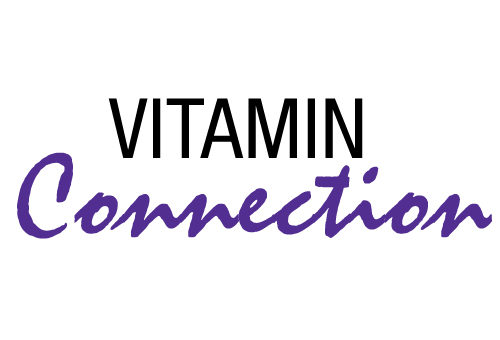Warning! Some readers may have their vitamin E knowledge foundation seriously “adjusted” by this provocative discussion. A few readers may be disturbed or even shocked by the “growing gorilla in the room,” suggesting that the most common form of vitamin E in supplements (alpha-tocopherol) may detrimentally interfere with other natural forms of vitamin E. As the body of science grows about the forms of vitamin E, surprises occur. Dogma must adapt to discovery. The objective is to utilize the new information to obtain even greater health benefits.
As we concluded our discussion last month with Barrie Tan, Ph.D., we promised that we would address the big question and hot topic of possible interference of alpha-tocopherol in supplements with the forms of vitamin E more frequently found in foods. Would this explain why some clinical studies with vitamin E supplements do not support the findings of some epidemiological studies based on dietary consumption?
On the other hand, many readers are well  aware of this information, as it is not actually new. It is just not discussed often, maybe in the hope that the issue will go away. Perhaps, now is the time for such talk and certainly, Dr. Tan is the perfect scientist to lead this discussion.
aware of this information, as it is not actually new. It is just not discussed often, maybe in the hope that the issue will go away. Perhaps, now is the time for such talk and certainly, Dr. Tan is the perfect scientist to lead this discussion.
Over the past several months, we have been discussing the importance of various forms of vitamin E with Dr. Tan. Our discussion has highlighted that while all forms of vitamin E share some common health benefits, not all forms of vitamin E have equal benefits. Moreover, tocotrienols offer health benefits that tocopherols do not. In Part 1 (published in July 2012), we discussed the preventive role of tocotrienol against cancer. In Part 2 (published in August 2012), we discussed additional health benefits specific to tocotrienols. This month, we will focus more closely on several other forms of vitamin E, particularly alpha-tocopherol, and examine the interference of tocopherols with tocotrienols.
The known health benefits of vitamin E are wide-ranging, with too many to mention in detail here. Still, it is important to note that, as extensive as vitamin E’s benefits are, they seem to be derived from actions that maintain and promote membrane health, lipid (fat) utilization and antioxidant protection.
Despite vitamin E’s manifold benefits, one problem is that most nutritionists and physicians seem to be confused about its actions, mainly because several vitamers have at least some vitamin E activity. As discussed in Part 1, various compounds qualify to be called vitamin E because they affect the fertility/sterility of animals. However, since these are different compounds, they also have different biochemical actions. To lump these various nutrients together and call them “vitamin E” as if they were all one and the same is incorrect. They are no more identical than are the various selenium compounds that most nutritionists and physicians mistakenly lump together simply as “selenium,” as if these organic compounds were merely a simple inorganic mineral form of selenium. Simple nutrient forms of iron or sodium can be considered in this manner because of their straightforward biochemistry, but not selenium, which has a very complex biochemistry of which many nutritionists and physicians are completely unaware.
The various members of the vitamin E family have more complex and individual biochemistries than simpler vitamins such as vitamin C (ascorbate). Studies show that the biochemistry of a specific E vitamer can be unique according to its unsaturation (tocopherol or tocotrienol), isomer 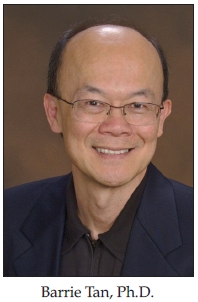 (alpha-, beta- gamma- or delta-) or esterification (acetate or succinate). Do the various family members complement or interfere with each other? Dr. Tan will discuss this further in this interview.
(alpha-, beta- gamma- or delta-) or esterification (acetate or succinate). Do the various family members complement or interfere with each other? Dr. Tan will discuss this further in this interview.
When considering clinical study results, it is important to know which specific form of vitamin E was used. Did the research involve tocopherols, tocotrienols or both? Was it natural or synthetic vitamin E? Was it alpha- or gamma-tocopherol?
It is also important to know and understand the differences between commercial forms of vitamin E such as “alpha-tocopherol,” “mixed-tocopherols” and “complete vitamin E” or “full-spectrum vitamin E.”
Let’s chat with Dr. Tan about these issues. Dr. Tan earned his doctorate in chemistry with emphasis on biochemistry at the University of Otago, New Zealand. He later became a professor of chemistry and food science/nutrition at the University of Massachusetts, Amherst. His research expertise includes lipid-soluble materials such as carotenoids, tocotrienols/tocopherols, CoQ10, omega-3s and cholesterol. He was the first to introduce tocotrienol’s benefits to the nutrition industry. He founded American River Nutrition Inc. in 1998 and developed the first-ever tocopherol-free tocotrienol product derived from annatto beans. Today, the focus of his research is on lipid-soluble nutrients that have an impact on chronic and degenerative conditions. Dr. Tan was elected to be senior editor of a compilation with a broad focus on tocotrienols, Tocotrienols: Vitamin E Beyond Tocopherols (AOCS & CRC Press; Fall 2012), and was the organizer of the 2nd International Tocotrienol Symposium in conjunction with the 103rd Annual Meeting of the American Oil Chemists’ Society (Long Beach, CA; April 29, 2012).
Passwater: Dr. Tan, last month, while we were discussing tocotrienols and cholesterol deposits in arteries, I was reminded of an interview with Drs. Marvin Bierenbaum and Tom Watkins about tocotrienols and reversing the cholesterol plaques in carotid arteries (http://www.drpasswater.com/nutrition_library/bierenbaum.html). Can you give us a summary of their study?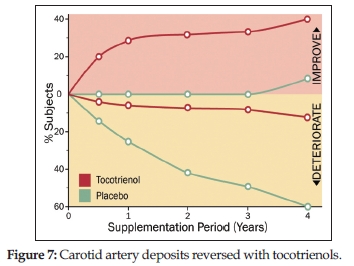
Tan: I am glad you are bringing up Drs. Bierenbaum and Watkins. Their study stretched over four years, making it the longest clinical trial using tocotrienols (71). The results showed that a stunning 88% of subjects taking tocotrienols either improved or stabilized their carotid atherosclerosis, while 60% of subjects on the placebo deteriorated (see Figure 7). Regression of the atherosclerotic plaques could be observed within six months. Cholesterol, however, did not drop until the fourth year of the study. The researchers attributed tocotrienol’s anti-plaque properties to antioxidant activity.
A molecular underpinning was not studied at the time. Many believe that a high-fat and/or a high-cholesterol diet promotes atherosclerosis. There is also evidence that inflammation may be involved. When tocotrienol was used to test the progression of atherosclerotic lesions in two animal studies, pure tocotrienol was more effective than either a tocopherol–tocotrienol mixture (with 30% alpha-tocopherol) or alpha-tocopherol (without tocotrienol) (72, 73) (see Figure 8).
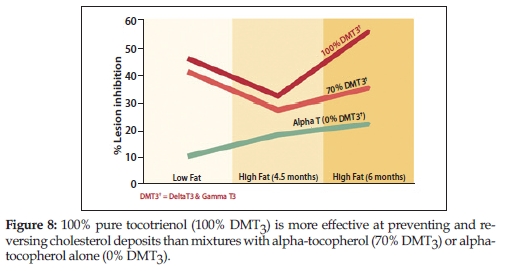
It is clear that alpha-tocopherol is, at best, less effective in cholesterol/atherosclerotic lesion reduction, and it may be speculated that alpha-tocopherol delays or reduces the effects of tocotrienol on atherosclerosis. This may in part explain the delayed and reduced effect on cholesterol reduction in the four-year clinical study by Drs. Bierenbaum and Watkins.
Passwater: Alpha-tocopherol interference with tocotrienol benefits is an interesting thought to which we will return later. What is the latest research on tocotrienols and reversing cholesterol plaques, or carotid arteries in general?
 Tan: Currently, we are back to animal studies that further explore the molecular underpinnings of tocotrienol’s anti-atherosclerotic properties. Malaysian researchers at the Universiti Teknologi MARA examined tocotrienol’s effect on various hallmarks of atherosclerosis, including inflammation and lipids. A tocotrienol–tocopherol mixture significantly reduced atherosclerotic lesions when used as a preventive measure, and also reduced inflammatory markers such as C-reactive protein (CRP) and interleukin-6 (IL-6). In addition, annatto tocotrienol, but not the tocotrienol–tocopherol mixture, reduced lipid levels. Low-dose tocotrienols appear to be more effective than high doses (74). A clinical study to confirm these findings is anticipated.
Tan: Currently, we are back to animal studies that further explore the molecular underpinnings of tocotrienol’s anti-atherosclerotic properties. Malaysian researchers at the Universiti Teknologi MARA examined tocotrienol’s effect on various hallmarks of atherosclerosis, including inflammation and lipids. A tocotrienol–tocopherol mixture significantly reduced atherosclerotic lesions when used as a preventive measure, and also reduced inflammatory markers such as C-reactive protein (CRP) and interleukin-6 (IL-6). In addition, annatto tocotrienol, but not the tocotrienol–tocopherol mixture, reduced lipid levels. Low-dose tocotrienols appear to be more effective than high doses (74). A clinical study to confirm these findings is anticipated.
Passwater: In the 2008 interview, you discussed the relatively new and controversial concept of tocotrienol interference by alpha-tocopherol. Where does this stand today? Could you give us an update?
Tan: At the time I was a lone ranger when bringing up this “interference” topic. Today, there is compelling and growing evidence that alpha-tocopherol interferes with tocotrienols in several ways. Tocopherols have even been shown to prevent absorption and organ/tissue delivery of tocotrienols (75–77). In combination with tocotrienol, alpha-tocopherol interferes with tocotrienol benefits directly by compromising cholesterol reduction (78, 79)], attenuating cancer cell inhibition (80, 81), blocking tocotrienol absorption (75, 77) and inducing tocotrienol catabolism (or breakdown) (82) (Table 1A).
Interestingly, alpha-tocopherol interferes with other tocopherols, too (Table 1B). The popular belief is that if alpha-tocopherol is good, then the “full-spectrum” nature-made mixed tocopherols also must be good. While the mixed tocopherols or “full-spectrum” concepts may be good for plants, they are not necessarily the optimal choice for humans.
By itself, alpha-tocopherol may lead to other predicaments, potentially causing the premature catabolism of prescription drugs (83, 84), increasing cholesterol and blood pressure (78, 79, 85–87), increasing prostate cancer risk in humans (88, 89) and decreasing bone mass (90) (Table 1C). We have reviewed various studies where alpha-tocopherol levels >20% interfere with tocotrienol functions (91).

Passwater: It’s important to note that you said alpha-tocopherol interferes with other tocopherols. Many people take mixed tocopherol supplements, including the delta- and gamma-tocopherols. What should we be aware of?
Tan: Alpha-tocopherol is no longer considered innocuous, but may be a liability to all other forms of vitamin E, tocopherols and tocotrienols alike. Alpha-tocopherol is most abundantly found in the blood and tissues, and is usually considered “the” vitamin E. This is a mistake. As one researcher noted, “a robust cancer prevention or anticancer activity of alpha-tocopherol has never been shown in studies with animal models or cell lines” (92).
In addition, alpha-tocopherol not only failed to exhibit anticancer properties, but instead reduced the anticancer action of gamma-tocopherol in vivo (93), while levels of gamma-tocopherol were decreased by supplementation with alpha-tocopherol (77, 94). In a review seven years ago (95), I wrote that alpha-tocopherol reduced both gamma-tocopherol and delta-tocopherol in humans (96, 97). This interference of tocopherols by alpha-tocopherol had been reported more than 25 years ago, but few people were paying attention. If we believe gamma- and delta-tocopherols are good for us, we should pay attention.
Here is my conclusion on vitamin E: a) alpha-tocopherol needs to be de-emphasized, b) delta- and gamma-tocopherol need to be emphasized, and c) delta- and gamma-tocotrienol need to be emphasized even more.
Passwater: Rather than mg/d, consumers use international units (IU) as the currency for vitamin E. Could you clarify why this is the case?
Tan: The use of IU currency for vitamin E is 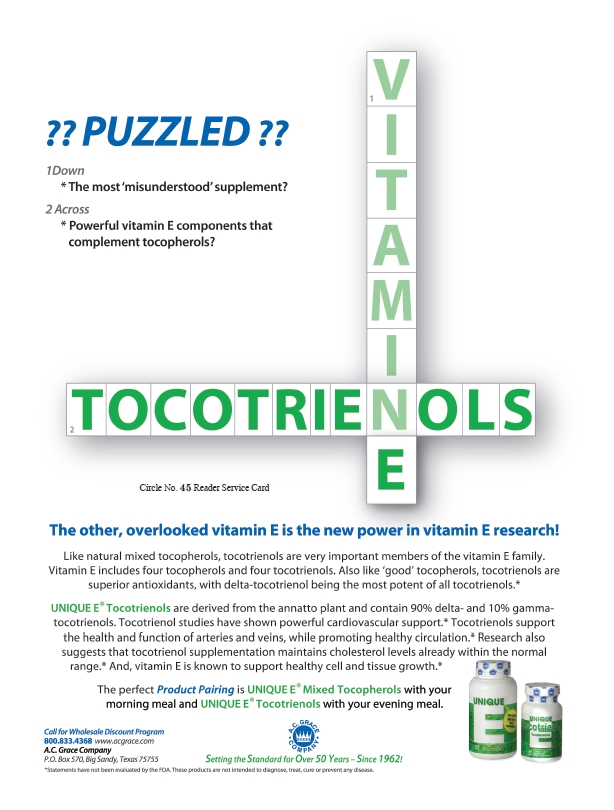 old-fashioned and should be abandoned. This IU currency came from the original discovery where alpha-tocopherol was tested on female rats’ ability to bear young. When a vitamin E-deficient diet was administered, the fetus eventually became unable to sustain to full term—called rat fetal resorption test—and an IU measurement was devised to quantify vitamin E. This test was used for everything from natural and synthetic alpha-tocopherol to all the esters in order to produce a common currency.
old-fashioned and should be abandoned. This IU currency came from the original discovery where alpha-tocopherol was tested on female rats’ ability to bear young. When a vitamin E-deficient diet was administered, the fetus eventually became unable to sustain to full term—called rat fetal resorption test—and an IU measurement was devised to quantify vitamin E. This test was used for everything from natural and synthetic alpha-tocopherol to all the esters in order to produce a common currency.
There are two big problems with this currency. First, men cannot bear children, and hence the idea of them taking 400 IU/d for vitamin E’s original application doesn’t make sense. This “birth vitamin” is meaningless to half of the world! Second, the IU currency was intended for alpha-tocopherol and all its derivatives, and really does not apply to all the other tocopherols and tocotrienols. Today, the focus has been reversed, where the limelight is on all the other vitamin E molecules, not alpha-tocopherol. The take-home message is that consumers should insist on finding out the mg/day dose, and forget about the IU currency with respect to vitamin E.
Passwater: If so much good is now coming from the new vitamin E tocotrienol, is there any need to supplement for alpha-tocopherol? If so, for what reason?
Tan: Yes, but not for the prevention of fetal resorption. No human study has ever documented this probably because the small amounts of alpha-tocopherol women need they readily obtain from the diet. Rather, the need of alpha-tocopherol is decidedly for people with malabsorption. Andreas Papas described this in his book, The Vitamin E Factor (98). Examples of malabsorption conditions include inflammatory bowel syndrome (IBS) (e.g., Crohn’s disease, ulcerative colitis), cystic fibrosis, cholestasis, abetalipoproteinemia and Friedreich’s ataxia, which is a rare genetic condition in which individuals cannot make (or make defective) ATTP. The first three are the most common conditions, and in decreasing order—IBS, cystic fibrosis, cholestasis—will benefit from alpha-tocopherol, in particular the alpha-tocopherol TPGS form.
Passwater: The body receives several forms of vitamin E in the diet, yet the body—or at least the blood—seems to have a preference for holding on to alpha-tocopherol. In this column in 1998, Dr. Maret Traber discussed the alpha-tocopherol transfer protein (ATTP), which preferentially transports and transfers the alpha-tocopherol form of vitamin E. (http://www.drpasswater.com/nutrition_library/traber3.html) Is this still an accurate finding and, if so, why does the body need ATTP?
Tan: Perhaps we should take a step back to look at the world of blood. The blood alpha-tocopherol is always ≥80%, gamma-tocopherol is ≤10%, and all the other forms of vitamin E are ≤10%. So, the tocotrienol contribution to blood is perhaps about 5%. The well-conserved alpha-tocopherol in blood is due to the ATTP—a chaperone that holds the hands of alpha-tocopherol—that prevents vitamin E from being excreted or metabolized. The discovery of ATTP forces us to think about why the body conserves alpha-tocopherol. Some say that because the body evolved this protein, there must be a reason to keep the alpha-tocopherol. This is a reasonable a priori assertion, but not a truth.
Here is my take. There is a genetic condition where the body does not make ATTP (99). However, I believe this is exceedingly rare. I believe the ATTP preferentially selects alpha-tocopherol in the liver to be packaged into the lipoproteins (LDL, HDL and others) to preserve these labile proteins from oxidation when they circulate the 30,000 miles in our arteries. Such oxidative preservation is important because oxidized LDL is known to be atherogenic.
Passwater: Thank you for identifying alpha-tocopherol requirements for severe malabsorption conditions. But what about normal folks without the severe conditions you mentioned? Do they need alpha-tocopherol?
Tan: In 1998, the American Heart Association noted that “oxidation of lipoproteins plays an important role in the development of atherosclerosis, the disease process that leads to heart attacks (myocardial infarcts) and brain attacks (strokes)” (100). High LDL is potentially not good. Rancid or oxidized LDL is worse, a loose cannon. The ATTP ensures the preservation of alpha-tocopherol, aids alpha-tocopherol hitching a ride on the LDL, and this lipid-soluble antioxidant vitamin helps control the LDL from getting radical (pun intended). We also need alpha-tocopherol to protect all membranes throughout our bodies. I believe we have adequate alpha-tocopherol from leafy vegetables, vegetable oil and nuts, and a regular bowl of cereal. Supplementation should be controlled to aid the benefits of tocotrienol.
Passwater: There is a repeated need to explain the difference between “natural” and “synthetic” vitamin E. Can you clarify this in a new way for our audience besides what the descriptive words mean?
Tan: Someone may exclaim, “A vitamin E is a vitamin E is a vitamin E!” Now, this can be true in the chemical composition sense—that is they have the same atomic weights, carbon atoms, hydrogen and oxygen. But atoms are arranged in space to form a complete molecule; scientists call this spatial arrangement. When nature places atoms in only one arrangement, it is said that this molecule has one spatial isomer. This is the case for natural vitamin E—it is one specific isomer.
On the other hand, a synthetic vitamin E, say alpha-tocopherol, will have equal proportions of eight isomers (due to the current multi-step synthesis process) of which only one is nature-identical. The eight isomers produced are the uncontrolled and random consequences of chemical synthesis. It is a vitamin E in the legal chemical sense. Seven of the eight isomers (or 87.5%) are, however, counterfeit vitamin E.
Passwater: This is revealing indeed. You used the word “counterfeit” for the chemically made vitamin E. With all the alterations to the vitamin E molecule, what is considered “natural” and what is “synthetic”?
Tan: Today, most “natural” vitamin E comes from soy, which contains about 15% alpha-tocopherol and mainly delta- and gamma-tocopherol. This is more accurately called “natural-source” vitamin E. Two steps make this “natural” vitamin E synthetic or partially synthetic at best. First, all soy vitamin Es are chemically converted to alpha-tocopherol via methylation (adding methyl groups) in the manufacturing process. Second, all alpha-tocopherol thus made is chemically converted to the various esters. These alpha-tocopherol vitamin Es are hardly “natural.” However, since tocotrienols are extracted “as is,” they are naturally composed, and not chemically altered.
Passwater: What are the downsides of this synthesized vitamin E?
Tan: In numerous large trials, vitamin E interventions came up empty-handed. The most recent SELECT II trial suggested that vitamin E increased the risk of prostate cancer. The headlines reported, “Vitamin E Causes Cancer!” The public got scared, and some understandably stopped taking vitamin E. Unfortunately (though typical), the headlines and news reports did not clarify that this study was conducted with synthetic vitamin E alpha-tocopherol. The vitamin E used is very different from natural vitamin E; only 12.5% is the real McCoy. And, how does the 87.5% of counterfeit E behave inside our bodies? The press did not understand this deep enough to report. The message we can learn from the SELECT II trial: avoid synthetic vitamin E!
Passwater: I was aware that you are a tocotrienol expert. Today, however, you have provided insights on delta and gamma tocopherols as well. Could you put this in a nutshell for us?
Tan: I like to explain the uniqueness of delta and gamma forms of tocotrienols and tocopherols in the way a chemist looks at a molecule. These vitamin E molecules are like tadpoles (101); they contain a “head” that eats away damaging radicals to protect lipids in membranes and a “tail” that wiggles and anchors into lipid membranes, like swimming in a pool. When it wiggles with a shorter tail (as in 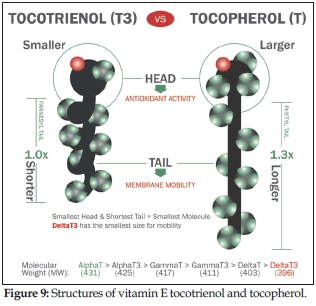 tocotrienol) it is more mobile and swims free-style. When it anchors with a longer tail (as in tocopherol), it is less agile and swims afloat. Hence, I have oft-illustrated the tocotrienol–state trooper connection (moving statewide) and the tocopherol–police connection (circling the town). Tocotrienol catches the bad guys “fast and furious” over a larger jurisdiction.
tocotrienol) it is more mobile and swims free-style. When it anchors with a longer tail (as in tocopherol), it is less agile and swims afloat. Hence, I have oft-illustrated the tocotrienol–state trooper connection (moving statewide) and the tocopherol–police connection (circling the town). Tocotrienol catches the bad guys “fast and furious” over a larger jurisdiction.
For further ease of mobility, a smaller head is best when it bops up-and-down in the pool like a buoy (102). Chemically, a delta head is defined smallest, gamma and beta heads are intermediate, and the alpha head is largest (Figure 9). Put together, the most agile vitamin E has the shortest tail and the smallest head—in other words, the smallest size.
Here is the bottom line: Alpha-tocopherol has the largest size (biggest molecular weight) and delta-tocotrienol has the smallest size (smallest molecular weight). Delta-tocotrienol is the only vitamin E with a molecular weight less than 400 Daltons.
This chemical rationalization explains the benefits observed for tocotrienols over tocopherols. It further explains why delta and gamma are more effective for the tocotrienol series as well as for the tocopherol series. This chemistry fits biology.
Passwater: It fits indeed, and I like the explanation. Let’s look at another complication for a moment. Ester forms of vitamin E (such as alpha tocopheryl acetate and others) are often used in dietary supplements. Esters can be identified by the “-yl” suffix rather than the “-ol” suffix of the free-alcohol form of vitamin E. Are these esters of tocopherol and tocotrienol found naturally in plants?
Tan: It is uncommon—almost nonexistent—that these vitamin E esters are produced in the plant kingdom. Chemists synthesize the “ester” form. When an ester caps over an alcohol, it locks up the antioxidant potential of the molecule completely because the alcohol is permanently blocked. Nature makes these vitamins “free alcohols” because the alcohol is the antioxidant protector—plants make only tocopherols and tocotrienols.
Passwater: Why were these esters of alpha-tocopherol chemically made?
Tan: Esters were only made of alpha-tocopherol, but none of the other vitamin E forms. They are made because they increase alpha-tocopherol’s stability outside the human body, particularly for food and beverage applications. Alpha-tocopheryl acetate is an oil, just like alpha-tocopherol, and its application is in lipids, oils, fats and softgels. Alpha-tocopheryl succinate is a powder, and its application is great for tablets and capsules. The other esters (linoleate, palmitate, nicotinate) of alpha-tocopherol are used in cosmetics and pharmas. Lastly, there is the water-soluble tocopherol polyethylene glycol succinate (TPGS). This is really an alpha-tocopherol succinate wrapped up in polyethylene glycol that forms micelles in water. It is great for beverage application or for people with malabsorption. Since all tocotrienols and tocopherols are oils, taking them in a softgel and as the alcohol form is best, and with a meal to promote emulsification and absorption.
Passwater: Are tocotrienols converted into their esters for preserving their antioxidant activity?
Tan: This is a very interesting question. To date, all tocotrienols are extracted from nature, and therefore are in the free-alcohol form; no tocotrienol esters exist in the market. Some 15 years ago, we synthesized tocotrienol esters in the lab, and they are stable, much like tocopherol esters. We did not pursue this line of research because those esters were not natural, and we had to employ chemical means. Besides, clinical studies using synthesized tocotrienol esters were equivocal (103). The “plain vanilla” free alcohol tocotrienol from nature works just fine. We therefore use it “as is” rather than altering what nature has quietly and unspokenly perfected.
Passwater: Studies suggest that the vitamin E ester tocopherol succinate may be more effective in quenching reactive nitrogen species radicals (RNS) than the non-esterified (free-alcohol form) vitamin E, alpha tocopherol. RNS are implicated in arthritis and Alzheimer’s disease, among other disorders and diseases. Can you briefly touch on this subject?
Tan: Tocopherol succinate is hydrolyzed in the gut into alpha-tocopherol. If, in fact, alpha-tocopherol succinate did work to quench RNS and reverse maladies such as arthritis and Alzheimer ’s disease, it is due to alpha-tocopherol itself, as alpha-tocopherol succinate is all but lost in the gut.
Passwater: Yes, the gut converts the esters back into the free-alcohol forms, but several of the studies were not done in humans or other animals, but in laboratory glassware (in vitro). Such studies suggested that alpha tocopheryl succinate is more effective against cancer than alpha tocopheryl acetate. These studies concluded that the succinate ester prolongs cell cycle arrest, induces apoptosis and acts as a radiosensitizer (104). What can you tell our readers about these conclusions?
Tan: Yes, alpha-tocopheryl succinate was very effective in killing cancer in vitro, and indeed was the main vitamin E therapeutic agent, at least until tocotrienol showed up on the scene. The mere fact is that it hydrolyzes in the gut— reducing alpha-tocopheryl succinate to alpha-tocopherol—leaving only alpha-tocopherol to be absorbed in the body. Therefore, in vivo studies did not mirror the positive in vitro findings.
The discovery by Dr. Kedar N. Prasad of alpha-tocopheryl succinate in cancer kill brought a lot of excitement to the vitamin E community in 1982 (which ironically is also the same year that Drs. A.A. Qureshi and C.E. Elson showed tocotrienol to have differentiated properties from tocopherol). The excitement lasted about two decades too long.
First, almost all of the compelling proof comes from cell line studies (105–112). Since a cell line study cannot mimic the hydrolysis of alpha-tocopherol succinate in the gut, the cancer kill is due to this synthetic version of vitamin E. In whole animal studies, on the other hand, alpha-tocopherol succinate converts to alpha-tocopherol, and cancer kill is not observed or results are blunted.
Second, the chemical strategy was to substitute the alcohol group located in the C6 position of the molecule with an ester, and in this case, the most powerful of them—a succinate ester. Locking up the C6 position locks up all antioxidant potential of the vitamin E whether or not the antioxidant effect is utilized in cancer kill. Today, the strategy is to keep the C6 as unsubstituted alcohol, and to move away from the alpha-isomer into delta- and gamma-isomers, particularly those of the tocotrienol series.
Third, Dr. Mokenge Malafa was among the first to conduct animal studies (113–115). This was due to the conversion of alpha-tocopherol succinate to alpha-tocopherol in patients. Today, Dr. Malafa’s strategy is to use delta-tocotrienol—he found this vitamin E molecule to be the most potent of all tested—in pancreatic cancer (116) and later colorectal cancer (117). His completed phase I clinical trials showed promising leads in pancreatic cancer patients. A phase II trial is in the works.
All this to say that alpha-tocopherol succinate is an excellent scientific find and revealed mechanisms that researchers followed. It did not pan out in tests with animals and humans, and at the same time, tocotrienols showed up as a successful replacement. This is especially true in the case of cancer studies.
Passwater: As you mentioned, Dr. Prasad was the first to show that alpha-tocopheryl succinate kills cancer in vitro in 1982. How does its effect compare to tocotrienols?
Tan: Alpha-tocopheryl succinate works exceedingly well as an intact molecule. In their isolated versions—alpha-tocopherol, succinate or mixtures of alpha-tocopherol and succinate—do not work. Dr. Prasad believed that alpha-tocopheryl succinate entered cells faster (105), giving it the ability to kill cancer. This is exactly what delta-tocotrienol does (118, 119). However, our bodies’ enzymes break up the alpha-tocopheryl succinate to inactive alpha-tocopherol, whereas the enzymes cannot break up delta-tocotrienol. This may be the underlying reason why both alpha-tocopheryl succinate and delta-tocotrienol kill cancer in cell line studies, but only delta-tocotrienol works in the whole body.
The first publication of tocopherol succinate’s potential as a direct antiproliferative agent was in 1982, when Kedar Prasad and Judith Edwards-Prasad tested several analogues of alpha-tocopherol, all using substitution of the hydroxyl group at the C6 position, for uptake and growth inhibition of melanoma cells in vitro. They found tocopherol succinate was the only analogue able to inhibit growth of melanoma cells (105). Over the ensuing decades, in vitro studies of various cell lines confirmed the antiproliferative/pro-apoptotic effects of tocopherol succinate. Neuroblastoma (107), glioma (106), gastric (110), lymphoma (109), breast (108), prostate (120), pancreatic, colon, leukemic and oral squamous carcinoma cell lines all showed growth inhibition with tocopherol succinate (106). Several in vivo studies have corroborated the growth-inhibitory effects for a variety of cancers, including oral, breast, melanoma, lung, and prostate (113–115, 121, 122).
Passwater: What are the differences between single-entity formulas such as alpha tocopherol or delta tocotrienol, mixed tocopherols and complete or total vitamin E?
Tan: Alpha-tocopherol (as is) exists in both natural and synthetic versions. Mixed tocopherols are usually derived from soy, and are high in gamma- and delta-tocopherol. Delta-tocotrienol does not come as a single-entity formula, but could be derived from one of three natural sources, which include annatto, palm and rice. Of these, annatto contains the largest amount of delta-tocotrienol, and is the only tocotrienol source that is naturally tocopherol-free. A so-called complete vitamin E formulation usually contains both tocopherols and tocotrienols, sometimes with added alpha-tocopherol.
Passwater: What are your recommendations for those that would like to continue taking tocopherols in addition to tocotrienols?
Tan: To us, the evidence of alpha-tocopherol interference is compelling based on preclinical and clinical studies. We recommend that tocopherols be taken separately from tocotrienols. For example, tocopherols could be taken with breakfast and tocotrienols at dinner or lunchtime. This makes good sense, and taking the supplement with a meal will increase absorption in the gut (123).
Passwater: Why do you think so many people still have not heard about tocotrienol? Why is the understanding of alpha-tocopherol so dominant?
Tan: A great question. Shaking off the understanding that alpha-tocopherol is “the” vitamin E has proven extremely difficult. This is because a) it has taken up the published article space for almost one century, b) it has lasting and persistent presence in the blood, c) it has been assigned huge and misguided IU value among vitamin E molecules, and d) it is repeatedly reported and communicated as a singular molecule.
However, this is positively changing, not just because tocotrienol functions are superior, but also large-scale tocopherol studies have failed to yield expected outcomes. Vitamin E benefits are no longer sustainable by alpha-tocopherol alone; they must include the other tocotrienols and tocopherols.
Passwater: Nutritionists still like to lump all vitamers of vitamin E as “vitamin E” instead of evaluating each form independently. Perhaps, not many nutritionists are aware of the magnitude of importance of the differences between the various vitamers. In my humble opinion, gamma-tocopherol, mixed tocopherols, tocotrienols, alpha-tocopherol, tocopheryl succinate, etc. should be clearly identified in all such discussions of studies with nutrients having vitamin E activity. Do you share my view that nutritionists as well as researchers should distinguish between the form of vitamin E used in studies, rather than just saying “vitamin E?”
Tan: Resounding Yes! Alpha-tocopherol was first discovered from lettuce to prevent fetal resorption 90 years ago by Drs. Herbert M. Evans and Katherine S. Bishop (124) of University of California Berkeley. Alpha-tocopherol came to be known as “vitamin E.” Then, alpha-tocotrienol was first discovered from barley to prevent hypercholesterolemia 30 years ago by Drs. Qureshi and Elson (125) of the University of Wisconsin Madison. In intervening times, delta- and gamma-tocopherols—not alpha-tocopherol—came to be known as stronger antioxidants (126), and delta- and gamma-tocotrienols—not alpha-tocotrienol—came to be known as better anti-lipidemic and anticancer agents. Because scientific understanding is evolving and clarifying with progress, so is the understanding of vitamin E.
Passwater: Let’s get back to tocotrienols. What is the daily recommended dosage?
Tan: Clinical studies determined an optimal dose of 100 mg/day of tocotrienol to maintain healthy lipids such as cholesterol and triglyceride (127). Higher doses are shown for other indications.
Passwater: General messages and sound bites may have confused some of our readers. Let’s leave them with a simple take home message(s).
Tan: Vitamin E is a collective description for eight compounds, four tocopherols and four tocotrienols.  Tocotrienols trump tocopherols in function, especially delta- and gamma-tocotrienols. There are merits to delta- and gamma-tocopherols. Alpha-tocopherol, the most prevalent of vitamin E, can interfere with tocotrienol functions, and should be taken separately. All vitamin Es should be taken as the alcohol forms with dinner or lunch.
Tocotrienols trump tocopherols in function, especially delta- and gamma-tocotrienols. There are merits to delta- and gamma-tocopherols. Alpha-tocopherol, the most prevalent of vitamin E, can interfere with tocotrienol functions, and should be taken separately. All vitamin Es should be taken as the alcohol forms with dinner or lunch.
Passwater: Thank you, Dr. Tan, for a most informative discussion. Next month, let’s continue with a review of the very latest tocotrienol research from the 2nd International Tocotrienol Symposium in Long Beach, CA on April 29, 2012. WF
Dr. Richard Passwater is the author of more than 45 books and 500 articles on nutrition. Dr. Passwater has been WholeFoods Magazine’s science editor and author of this column since 1984. More information is available on his Web site, www.drpasswater.com.
References
The complete references will be given at the conclusion of Part 4.
Published in WholeFoods Magazine, September 2012

